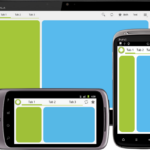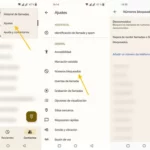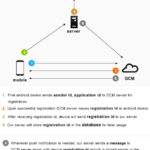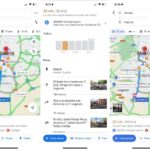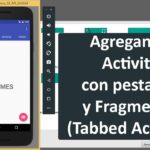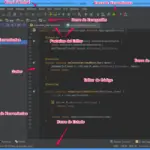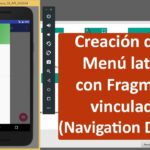En este tutorial, aprenderá cómo implementar la navegación del menú lateral ActionBarSherlock con pestañas de fragmentos en su aplicación de Android. El cajón de navegación es un panel que pasa desde el borde izquierdo de la pantalla y muestra las principales opciones de navegación. El uso de un cajón de navegación del menú lateral permite al usuario navegar fácilmente entre fragmentos o actividades. El cajón de navegación se puede traer a la pantalla deslizando el dedo desde el borde izquierdo de la pantalla o tocando el icono de la aplicación en la barra de acción. Crearemos un cajón de navegación de menú lateral personalizado usando ActionBarSherlock Library y en el elemento de menú seleccionado, al hacer clic se mostrará un fragmento y un fragmento con pestañas. Vamos a empezar…
Descargue la biblioteca de soporte más reciente
Descargue la última revisión de la biblioteca de soporte 13 que admite el nuevo Cajón de navegación.
Enlace: http://developer.android.com/tools/extras/support-library.html
Reemplace la biblioteca de soporte anterior ( android-support-v4.jar ) con la nueva biblioteca de soporte en su biblioteca ActionBarSherlock.
Paquete de soporte, revisión 13
- Cambios para la biblioteca de soporte v4:
-
- Se agregó DrawerLayout para crear un cajón de navegación que se puede extraer desde el borde de una ventana.
Prepare su proyecto importando la biblioteca ActionBarSherlock . Consulte el tutorial Implementación de ActionBarSherlock en Android .
Cree un nuevo proyecto en Eclipse File > New > Android Application Project. Complete los detalles y nombre su proyecto SideMenuTabsTutorial .
Nombre de la aplicación: SideMenuTabsTutorial
Nombre del proyecto: SideMenuTabsTutorial
Nombre del paquete: com.androidbegin.sidemenutabstutorial
Abra su MainActivity .java y pegue el siguiente código.
Actividad principal .java
paquete com.androidbegin.sidemenutabstutorial; importar com.actionbarsherlock.app.SherlockFragmentActivity; importar com.actionbarsherlock.view.Menu; importar com.actionbarsherlock.view.MenuItem; importar android.support.v4.app.FragmentTransaction; importar android.support.v4.app.Fragment; importar android.content.res.Configuration; importar android.os.Bundle; importar android.support.v4.app.ActionBarDrawerToggle; importar android.support.v4.widget.DrawerLayout; importar android.view.View; importar android.widget.AdapterView; importar android.widget.ListView; importar android.support.v4.view.GravityCompat; clase pública MainActivity extiende SherlockFragmentActivity { // Declarar variable DrawerLayoutmDrawerLayout; ListView mDrawerList; ActionBarDrawerToggle mDrawerToggle; MenuListAdapter mMenuAdapter; Cadena[] título; Cadena[] subtítulo; icono int[]; Fragmento fragmento1 = nuevo Fragmento1(); Fragmento fragmento2 = nuevo Fragmento2(); @Anular public void onCreate (Paquete guardadoInstanceState) { super.onCreate(estadoDeInstanciaGuardado); setContentView(R.layout.drawer_main); // Generar titulo title = new String[] { "Título Fragmento 1", "Título Fragmento 2"}; // Generar subtitulo subtítulo = new String[] { "Fragmento de subtítulo 1", "Fragmento de subtítulo 2"}; // Generar icono icon = new int[] { R.drawable.action_about, R.drawable.action_settings}; // Localiza DrawerLayout en el cajón_principal.xml mDrawerLayout = (DrawerLayout) findViewById(R.id.drawer_layout); // Localiza ListView en el cajón_principal.xml mDrawerList = (ListView) findViewById(R.id.left_drawer); // Establecer una sombra personalizada que superponga el contenido principal cuando el cajón // abre mDrawerLayout.setDrawerShadow(R.drawable.drawer_shadow, GravityCompat.INICIO); // Pasar los resultados a la clase MenuListAdapter mMenuAdapter = new MenuListAdapter(este, título, subtítulo, icono); // Establecer el MenuListAdapter en ListView mDrawerList.setAdapter(mMenuAdapter); // Captura los clics del botón en el menú lateral mDrawerList.setOnItemClickListener(nuevo DrawerItemClickListener()); // Habilitar el ícono de la aplicación ActionBar para que se comporte como una acción para alternar el cajón de navegación getSupportActionBar().setHomeButtonEnabled(true); getSupportActionBar().setDisplayHomeAsUpEnabled(true); // ActionBarDrawerToggle une las interacciones adecuadas // entre el cajón deslizante y el icono de la aplicación de la barra de acción mDrawerToggle = new ActionBarDrawerToggle(esto, mDrawerLayout, R.dibujable.ic_cajón, R.cadena.cajón_abierto, R.cadena.cajón_cerrar) { public void onDrawerClosed(Ver vista) { // TODO stub de método generado automáticamente super.onDrawerClosed(ver); } public void onDrawerOpened(Ver vista del cajón) { // TODO stub de método generado automáticamente super.enCajónAbierto(vistaCajón); } }; mDrawerLayout.setDrawerListener(mDrawerToggle); if (estadoInstanciaGuardada == nulo) { seleccionar elemento (0); } } @Anular public boolean onCreateOptionsMenu(Menú menú) { getSupportMenuInflater().inflate(R.menu.actividad_principal, menú); devolver verdadero; } @Anular onOptionsItemSelected booleano público (elemento MenuItem) { if (elemento.getItemId() == android.R.id.home) { si (mDrawerLayout.isDrawerOpen(mDrawerList)) { mDrawerLayout.closeDrawer(mDrawerList); } más { mDrawerLayout.openDrawer(mDrawerList); } } volver super.onOptionsItemSelected(elemento); } // El detector de clics para ListView en el cajón de navegación implementos de clase privada DrawerItemClickListener ListView.OnItemClickListener { @Anular public void onItemClick(AdapterView<?> parent, View view, int position, identificación larga) { seleccionar elemento (posición); } } selectItem vacío privado (posición int) { FragmentTransaction ft = getSupportFragmentManager().beginTransaction(); // Localizar posición interruptor (posición) { caso 0: ft.replace(R.id.content_frame, fragmento1); descanso; caso 1: ft.replace(R.id.content_frame, fragmento2); descanso; } ft.commit(); mDrawerList.setItemChecked(posición, verdadero); // Cerrar cajón mDrawerLayout.closeDrawer(mDrawerList); } @Anular vacío protegido en PostCreate (Paquete de estado de instancia guardado) { super.onPostCreate(estadoDeInstanciaGuardado); // Sincroniza el estado de alternancia después de que se haya producido onRestoreInstanceState. mDrawerToggle.syncState(); } @Anular public void onConfigurationChanged(Configuración newConfig) { super.onConfigurationChanged(newConfig); // Pasar cualquier cambio de configuración a los conmutadores del cajón mDrawerToggle.onConfigurationChanged(nuevaConfig); } }
En esta actividad, hemos creado algunos títulos, subtítulos e íconos de muestra en matrices de cadenas y números enteros y los pasamos a MenuListAdapter para mostrarlos en una vista de lista como un menú lateral. Al hacer clic en el menú lateral de la vista de lista, se mostrará el fragmento seleccionado junto con el título en la barra de acción. ActionBarDrawerToggle facilita el comportamiento de interacción adecuado entre el icono de la barra de acción y el cajón de navegación.
Hemos preparado algunos íconos de muestra para este tutorial. Inserte los íconos de muestra descargados en su res > drawable-hdpi .
Iconos de muestra
[etiqueta wpfilebase = ID de archivo = 49 tpl = botón de descarga /]
A continuación, cree un diseño gráfico XML para su cajón de navegación. Vaya a res > diseño > Haga clic con el botón derecho en el diseño > Nuevo > Archivo XML de Android
Asigne un nombre a su nuevo archivo XML cajón_principal.xml y pegue el siguiente código.
cajón_principal .xml
<android.support.v4.widget.DrawerLayout xmlns_android="http://schemas.android.com/apk/res/android" android_id="@+id/diseño_cajón" android_layout_width="match_parent" android_layout_height="match_parent" > <FrameLayout android_id="@+id/content_frame" android_layout_width="match_parent" android_layout_height="match_parent" /> <ListView android_id="@+id/cajón_izquierdo" android_layout_width="240dp" android_layout_height="match_parent" android_layout_gravity="inicio" androide_fondo="#111" android_choiceMode="singleChoice" android_divider="@android:color/transparente" android_dividerHeight="0dp" /> </android.support.v4.widget.DrawerLayout>
A continuación, cree una clase de adaptador de menú personalizado. Vaya a Archivo > Nuevo > Clase y asígnele el nombre MenuListAdapter .java. Seleccione su paquete llamado com.androidbegin. sidemenutabstutorial y haga clic en Finalizar .
Abra su MenuListAdapter .java y pegue el siguiente código.
MenuListAdapter .java
paquete com.androidbegin.sidemenutabstutorial; importar android.content.Context; importar android.view.LayoutInflater; importar android.view.View; importar android.view.ViewGroup; importar android.widget.BaseAdapter; importar android.widget.ImageView; importar android.widget.TextView; clase pública MenuListAdapter extiende BaseAdapter { // Declarar Variables contexto contexto; Cadena[] mTitulo; Cadena[] mSubTítulo; int[] icono; LayoutInflater inflador; Public MenuListAdapter (contexto contextual, título de cadena [], subtítulo de cadena [], int[] icono) { este.contexto = contexto; this.mTitle = título; this.mSubTitle = subtítulo; este.mIcon = icono; } @Anular public int getCount() { devuelve mTitulo.longitud; } @Anular objeto público getItem (posición int) { return mTitulo[posicion]; } @Anular getItemId largo público (posición int) { posición de retorno; } public View getView (posición int, View convertView, ViewGroup parent) { // Declarar Variables Vista de texto txtTitle; Vista de texto txtSubTitle; ImageView imgIcon; inflador = (LayoutInflater) contexto .getSystemService(Context.LAYOUT_INFLATER_SERVICE); Ver itemView = inflater.inflate(R.layout.drawer_list_item, padre, falso); // Localiza las Vistas de Texto en el cajón_lista_elemento.xml txtTitle = (TextView) itemView.findViewById(R.id.title); txtSubTitle = (TextView) itemView.findViewById(R.id.subtitle); // Ubique el ImageView en el cajón_lista_elemento.xml imgIcon = (ImageView) itemView.findViewById(R.id.icon); // Establecer los resultados en TextViews txtTitle.setText(mTitle[posición]); txtSubTitle.setText(mSubTitle[posición]); // Establecer los resultados en ImageView imgIcon.setImageResource(mIcon[posición]); volver itemView; } }
En esta clase de adaptador de menú personalizado, las matrices de cadenas y enteros se configuran en TextViews e ImageViews seguidas de las posiciones.
A continuación, cree un diseño gráfico XML para el elemento de menú de vista de lista. Vaya a res > diseño > Haga clic con el botón derecho en el diseño > Nuevo > Archivo XML de Android
Asigne un nombre a su nuevo archivo XML cajón_lista_elemento.xml y pegue el siguiente código.
cajón_lista_elemento .xml
<?versión xml="1.0" codificación="utf-8"?> <LinearLayout xmlns_android="http://schemas.android.com/apk/res/android" estilo="?attr/spinnerDropDownItemStyle" android_layout_width="match_parent" android_layout_height="?attr/dropdownListPreferredItemHeight" android:orientación="horizontal" > <ImagenVista android_id="@+id/icono" android_layout_width="wrap_content" android_layout_height="match_parent" android_justViewBounds="true" /> <LinearLayout android_layout_width="wrap_content" android_layout_height="match_parent" android_gravedad="centro_vertical|izquierda" android:orientación="vertical" > <Vista de texto android_id="@+id/título" estilo="?attr/spinnerDropDownItemStyle" android_layout_width="wrap_content" android_layout_height="wrap_content" Android: ellipsize = "fin" android_singleLine="verdadero" /> <Vista de texto android_id="@+id/subtítulo" estilo="?attr/spinnerDropDownItemStyle" android_layout_width="wrap_content" android_layout_height="wrap_content" Android: ellipsize = "fin" android_singleLine="verdadero" android_textAppearance="?attr/textAppearancePequeño" /> </LinearLayout> </LinearLayout>
A continuación, cree el primer fragmento. Vaya a Archivo > Nuevo > Clase y asígnele el nombre Fragmentos1 .java. Seleccione su paquete llamado com.androidbegin. sidemenutabstutorial y haga clic en Finalizar .
Abra su Fragments1 .java y pegue el siguiente código.
Fragmentos1 .java
paquete com.androidbegin.sidemenutabstutorial; importar java.lang.reflect.Field; importar com.actionbarsherlock.app.SherlockFragment; importar android.os.Bundle; importar android.support.v4.app.Fragment; importar android.support.v4.app.FragmentTabHost; importar android.view.LayoutInflater; importar android.view.View; importar android.view.ViewGroup; public class Fragment1 extiende SherlockFragment { // Declarar variable privado FragmentTabHost mTabHost; @Anular Public View onCreateView(LayoutInflater inflater, contenedor ViewGroup, Paquete guardadoInstanceState) { // Crear FragmentTabHost mTabHost = new FragmentTabHost(getSherlockActivity()); // Localiza fragment1.xml para crear FragmentTabHost mTabHost.setup(getSherlockActivity(), getChildFragmentManager(), R.layout.fragment1); // Crear pestaña 1 mTabHost.addTab(mTabHost.newTabSpec("tab1").setIndicator("Tab1"), FragmentTab1.class, null); // Crear pestaña 2 mTabHost.addTab(mTabHost.newTabSpec("tab2").setIndicator("Tab2"), FragmentTab2.class, null); volver mTabHost; } // Separar FragmentTabHost @Anular vacío público onDetach() { super.onDetach(); intentar { Field childFragmentManager = Fragmento.clase .getDeclaredField("mChildFragmentManager"); childFragmentManager.setAccesible(verdadero); childFragmentManager.set(esto, nulo); } captura (NoSuchFieldException e) { lanza una nueva RuntimeException(e); } captura (Excepción de acceso ilegal e) { lanza una nueva RuntimeException(e); } } // Eliminar FragmentTabHost @Anular vacío público onDestroyView () { super.onDestroyView(); mTabHost = nulo; } }
En este Fragment1, hemos creado dos pestañas que contienen fragmentos usando FragmentTabHost. Para obtener más información sobre FragmentTabHost, visite Android Docs aquí .
A continuación, cree un diseño gráfico XML para el primer fragmento. Vaya a res > diseño > Haga clic con el botón derecho en el diseño > Nuevo > Archivo XML de Android
Nombre su nuevo archivo XML fragment1.xml y pegue el siguiente código.
fragmento1 .xml
<RelativeLayout xmlns_android="http://schemas.android.com/apk/res/android" xmlns_herramientas="http://esquemas.android.com/herramientas" android_layout_width="match_parent" android_layout_height="match_parent" > </RelativeLayout>
A continuación, cree el segundo fragmento. Vaya a Archivo > Nuevo > Clase y asígnele el nombre Fragmentos2 .java. Seleccione su paquete llamado com.androidbegin. sidemenutabstutorial y haga clic en Finalizar .
Abra su Fragments2 .java y pegue el siguiente código.
Fragmentos2 .java
paquete com.androidbegin.sidemenutabstutorial; importar java.lang.reflect.Field; importar com.actionbarsherlock.app.SherlockFragment; importar android.os.Bundle; importar android.support.v4.app.Fragment; importar android.support.v4.app.FragmentTabHost; importar android.view.LayoutInflater; importar android.view.View; importar android.view.ViewGroup; public class Fragment2 extiende SherlockFragment { // Declarar variable privado FragmentTabHost mTabHost; @Anular Public View onCreateView(LayoutInflater inflater, contenedor ViewGroup, Paquete guardadoInstanceState) { // Crear FragmentTabHost mTabHost = new FragmentTabHost(getSherlockActivity()); // Localiza fragment2.xml para crear FragmentTabHost mTabHost.setup(getSherlockActivity(), getChildFragmentManager(), R.layout.fragment2); // Crear pestaña 3 mTabHost.addTab(mTabHost.newTabSpec("tab3").setIndicator("Tab3"), FragmentTab3.class, null); // Crear pestaña 4 mTabHost.addTab(mTabHost.newTabSpec("tab4").setIndicator("Tab 4"), FragmentTab4.class, null); volver mTabHost; } // Separar FragmentTabHost @Anular vacío público onDetach() { super.onDetach(); intentar { Field childFragmentManager = Fragmento.clase .getDeclaredField("mChildFragmentManager"); childFragmentManager.setAccesible(verdadero); childFragmentManager.set(esto, nulo); } captura (NoSuchFieldException e) { lanza una nueva RuntimeException(e); } captura (Excepción de acceso ilegal e) { lanza una nueva RuntimeException(e); } } // Eliminar FragmentTabHost @Anular vacío público onDestroyView () { super.onDestroyView(); mTabHost = nulo; } }
En este Fragment2, hemos creado dos pestañas que contienen fragmentos usando FragmentTabHost.
A continuación, cree un diseño gráfico XML para el segundo fragmento. Vaya a res > diseño > Haga clic con el botón derecho en el diseño > Nuevo > Archivo XML de Android
Nombre su nuevo archivo XML fragment2.xml y pegue el siguiente código.
fragmento2 .xml
<RelativeLayout xmlns_android="http://schemas.android.com/apk/res/android" xmlns_herramientas="http://esquemas.android.com/herramientas" android_layout_width="match_parent" android_layout_height="match_parent" > </RelativeLayout>
A continuación, cree la primera pestaña de fragmento. Vaya a Archivo > Nuevo > Clase y asígnele el nombre FragmentTab1 .java. Seleccione su paquete llamado com.androidbegin. sidemenutabstutorial y haga clic en Finalizar .
Abra su FragmentTab1 .java y pegue el siguiente código.
FragmentTab1 .java
paquete com.androidbegin.sidemenutabstutorial; importar com.actionbarsherlock.app.SherlockFragment; importar android.os.Bundle; importar android.view.LayoutInflater; importar android.view.View; importar android.view.ViewGroup; clase pública FragmentTab1 extiende SherlockFragment { @Anular Public View onCreateView(LayoutInflater inflater, contenedor ViewGroup, Paquete guardadoInstanceState) { Ver rootView = inflater.inflate(R.layout.fragmenttab1, container, false); volver rootView; } }
A continuación, cree la segunda pestaña de fragmento. Vaya a Archivo > Nuevo > Clase y asígnele el nombre FragmentTab2 .java. Seleccione su paquete llamado com.androidbegin. sidemenutabstutorial y haga clic en Finalizar .
Abra su FragmentTab2 .java y pegue el siguiente código.
FragmentTab2 .java
paquete com.androidbegin.sidemenutabstutorial; importar com.actionbarsherlock.app.SherlockFragment; importar android.os.Bundle; importar android.view.LayoutInflater; importar android.view.View; importar android.view.ViewGroup; clase pública FragmentTab2 extiende SherlockFragment { @Anular Public View onCreateView(LayoutInflater inflater, contenedor ViewGroup, Paquete guardadoInstanceState) { Ver rootView = inflater.inflate(R.layout.fragmenttab2, container, false); volver rootView; } }
A continuación, cree la pestaña del tercer fragmento. Vaya a Archivo > Nuevo > Clase y asígnele el nombre FragmentTab3 .java. Seleccione su paquete llamado com.androidbegin. sidemenutabstutorial y haga clic en Finalizar .
Abra su FragmentTab3 .java y pegue el siguiente código.
FragmentTab3 .java
paquete com.androidbegin.sidemenutabstutorial; importar com.actionbarsherlock.app.SherlockFragment; importar android.os.Bundle; importar android.view.LayoutInflater; importar android.view.View; importar android.view.ViewGroup; clase pública FragmentTab3 extiende SherlockFragment { @Anular Public View onCreateView(LayoutInflater inflater, contenedor ViewGroup, Paquete guardadoInstanceState) { Ver rootView = inflater.inflate(R.layout.fragmenttab3, container, false); volver rootView; } }
A continuación, cree la pestaña del cuarto fragmento. Vaya a Archivo > Nuevo > Clase y asígnele el nombre FragmentTab4 .java. Seleccione su paquete llamado com.androidbegin. sidemenutabstutorial y haga clic en Finalizar .
Abra su FragmentTab4 .java y pegue el siguiente código.
FragmentTab4 .java
paquete com.androidbegin.sidemenutabstutorial; importar com.actionbarsherlock.app.SherlockFragment; importar android.os.Bundle; importar android.view.LayoutInflater; importar android.view.View; importar android.view.ViewGroup; clase pública FragmentTab4 extiende SherlockFragment { @Anular Public View onCreateView(LayoutInflater inflater, contenedor ViewGroup, Paquete guardadoInstanceState) { Ver rootView = inflater.inflate(R.layout.fragmenttab4, container, falso); volver rootView; } }
A continuación, cree un diseño gráfico XML para la pestaña del primer fragmento. Vaya a res > diseño > Haga clic con el botón derecho en el diseño > Nuevo > Archivo XML de Android
Nombre su nuevo archivo XML fragmenttab1.xml y pegue el siguiente código.
fragmenttab1 .xml
<RelativeLayout xmlns_android="http://schemas.android.com/apk/res/android" xmlns_herramientas="http://esquemas.android.com/herramientas" android_layout_width="match_parent" android_layout_height="match_parent" > <Vista de texto android_layout_width="wrap_content" android_layout_height="wrap_content" android_layout_centerHorizontal="verdadero" android_layout_centerVertical="verdadero" android_text="@cadena/FragmentTab1" /> </RelativeLayout>
A continuación, cree un diseño gráfico XML para la segunda pestaña del fragmento. Vaya a res > diseño > Haga clic con el botón derecho en el diseño > Nuevo > Archivo XML de Android
Nombre su nuevo archivo XML fragmenttab2.xml y pegue el siguiente código.
fragmenttab2 .xml
<RelativeLayout xmlns_android="http://schemas.android.com/apk/res/android" xmlns_herramientas="http://esquemas.android.com/herramientas" android_layout_width="match_parent" android_layout_height="match_parent" > <Vista de texto android_layout_width="wrap_content" android_layout_height="wrap_content" android_layout_centerHorizontal="verdadero" android_layout_centerVertical="verdadero" android_text="@cadena/FragmentTab2" /> </RelativeLayout>
A continuación, cree un diseño gráfico XML para la pestaña del tercer fragmento. Vaya a res > diseño > Haga clic con el botón derecho en el diseño > Nuevo > Archivo XML de Android
Nombre su nuevo archivo XML fragmenttab3.xml y pegue el siguiente código.
fragmenttab3 .xml
<RelativeLayout xmlns_android="http://schemas.android.com/apk/res/android" xmlns_herramientas="http://esquemas.android.com/herramientas" android_layout_width="match_parent" android_layout_height="match_parent" > <Vista de texto android_layout_width="wrap_content" android_layout_height="wrap_content" android_layout_centerHorizontal="verdadero" android_layout_centerVertical="verdadero" android_text="@cadena/FragmentTab3" /> </RelativeLayout>
A continuación, cree un diseño gráfico XML para la pestaña del cuarto fragmento. Vaya a res > diseño > Haga clic con el botón derecho en el diseño > Nuevo > Archivo XML de Android
Nombre su nuevo archivo XML fragmenttab4.xml y pegue el siguiente código.
fragmenttab4 .xml
<RelativeLayout xmlns_android="http://schemas.android.com/apk/res/android" xmlns_herramientas="http://esquemas.android.com/herramientas" android_layout_width="match_parent" android_layout_height="match_parent" > <Vista de texto android_layout_width="wrap_content" android_layout_height="wrap_content" android_layout_centerHorizontal="verdadero" android_layout_centerVertical="verdadero" android_text="@cadena/FragmentTab4" /> </RelativeLayout>
A continuación, cambie el nombre y los textos de la aplicación. Abra su strings.xml en su carpeta res > valores y pegue el siguiente código.
cadenas.xml
<recursos> <string name="app_name">Tutorial de pestañas del menú lateral</string> <string name="hello_world">¡Hola mundo!</string> <string name="menu_settings">Configuración</string> <string name="title_activity_main">Tutorial de pestañas del menú lateral</string> <string name="drawer_open">Abrir cajón de navegación</string> <string name="drawer_close">Cerrar cajón de navegación</string> <string name="FragmentTab1">Esta es la pestaña Fragmento 1</string> <string name="FragmentTab2">Esta es la pestaña Fragmento 2</string> <string name="FragmentTab3">Esta es la pestaña Fragmento 3</string> <string name="FragmentTab4">Esta es la pestaña Fragmento 4</string> </recursos>
En su AndroidManifest.xml , debemos cambiar el estilo del tema a » Theme.Sherlock » y establecer la versión SDK mínima de Android que prefiera. Abra su AndroidManifest.xml y pegue el siguiente código.
AndroidManifest.xml
<manifiesto xmlns_android="http://schemas.android.com/apk/res/android" paquete="com.androidbegin.sidemenutabtutorial" android_versionCode="1" android_versionName="1.0" > <usos-sdk android_minSdkVersion="7" android_targetSdkVersion="15" /> <aplicación android_icono="@dibujable/ic_launcher" android_etiqueta="@cadena/nombre_aplicación" android_tema="@estilo/Tema.Sherlock" > <actividad android_nombre=".Actividad principal" android_label="@cadena/título_actividad_principal" > <intent-filter> <acción android_name="android.intent.action.MAIN" /> <categoría android_name="android.intent.category.LAUNCHER" /> </intent-filter> </actividad> </aplicación> </manifiesto>

